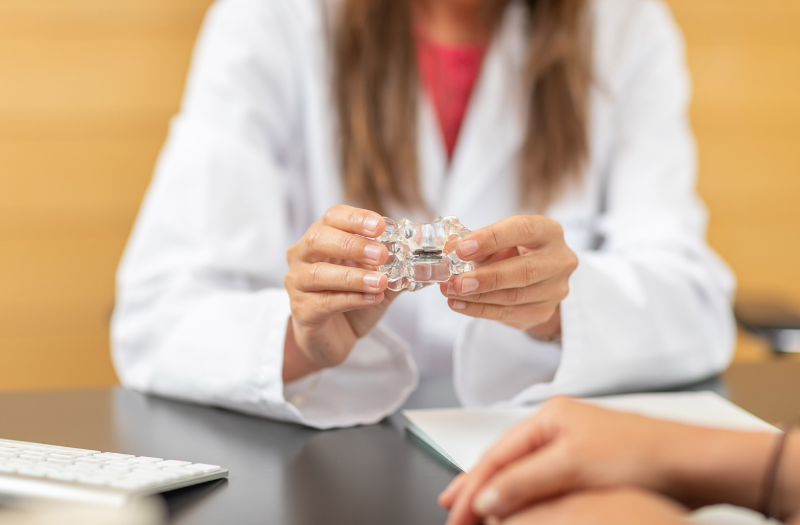Annoying back pain can be resolved with non-surgical treatments in 90% of cases. However, there are specific circumstances in which surgery is necessary. Dr. Varela explains here the types of cases in which a herniated disc needs surgery.
Disc herniation refers to a localized displacement of disc material beyond the normal margins of the vertebral disc space. It causes pain because it presses on the nerve root, which can result in nerve damage by both mechanical and chemical irritation of the nerve.
There is an intervertebral disc between each pair of spinal vertebrae. The inner part of a spinal disc is made up of a jelly-like substance, called the nucleus pulposus, and it is surrounded by a cartilaginous ring, the annulus fibrosus, that keeps it intact. The mechanical function of the discs is to act as shock absorbers for the impact placed on the spine by ordinary activities such as walking, running, and jumping.
Sometimes, the annulus fibrosus ruptures or tears, and the nucleus pulposus protrudes beyond the boundaries. This is a disc herniation, and depending on its size and location, it can cause neck pain, lower back pain, and/or pain in the arms or legs (if it compresses a nerve root).
Disc herniations are referred to by their location: cervical disc herniation (neck region), thoracic disc herniation (middle back) and lumbar disc herniation (lower back region).
The pain of a herniated disc can appear suddenly, and with proper treatment, the pain may go away after a short while. Things like resting, taking analgesic or anti-inflammatory medications, and doing physical therapy can often be effective in relieving symptoms of a herniated disc. But this does not work in every case, and that is when your doctor may recommend surgery for the herniated disc.
Consequences of not having surgery on a herniated disc
When to operate on a herniated disc
Whether we are talking about the cervical spine or the lumbar spine, the symptoms of a herniated disc can vary significantly. Although the most common symptom is pain in the arms or legs, there are other signs that can indicate you should see a doctor to find out if the problem is a herniated disc and whether surgery may be necessary.
Dr. María Dolores Varela, a specialist in minimally-invasive spine surgery, points out the three risk factors for herniated discs which require special attention, and when a herniated disc needs surgery:
- Muscle weakness in the arms, hands, legs, or feet. You might notice difficulty picking up objects, lifting the arm, or you may trip when walking because of difficulty raising the leg or foot. If weakness prevents you from moving your limbs, you should seek medical attention urgently.
- Lack of sensation, or a feeling of pins and needles or numbness in the arms, legs, buttocks, or feet. If you feel nothing when touched or pinched in these areas, you should go to the doctor.
- Loss of sphincter control. The nerves that are responsible for bowel and bladder control originate in an area of the lumbar spine that is susceptible to disc hernias. These hernias can have important consequences that can take effect rapidly. If you have urinary or fecal incontinence, you should seek medical attention urgently.

If the diagnosis or treatment of a disc herniation is delayed, there can be damage to the nerve roots, with consequences including chronic pain, partial paralysis, or irreversible loss of bowel control.
If, after following 6 to 8 weeks of conservative treatment, your pain and symptoms have not subsided, surgery will be required. Specifically, it is necessary to operate on a herniated disc when:
- There is loss of strength of upper or lower limbs.
- Pain does not improve with medication.
- Loss of sphincter control.
Depending on the type of disc herniation the patient has, there are different surgical treatments used:
- For lumbar disc herniation surgery, at Instituto Clavel we opt for a microdiscectomy or endoscopic lumbar discectomy. Both are minimally invasive techniques by which the herniated fragment is removed and, depending on the case, the affected disc is partially emptied. If the base of the hernia is very wide and there is bilateral root compression or other associated pathologies, a disc arthroplasty (ADR) will be performed. In this surgery, the damaged disc is replaced with an artificial disc prosthesis. If disc replacement surgery is not possible because the degenerative pathology of the patient’s spine is too severe, or there is another condition that prevents it, arthrodesis or fusion surgery can be performed.
- In cervical disc herniation surgery, we first perform cervical microdiscectomy using the anterolateral approach to minimize the manipulation of the nerves and spinal cord. Following this, it will be necessary to ADR surgery, replacing the worn disc with an artificial one which will allow the patient to retain the natural mobility of their spine.
Thanks to the minimally invasive technique we use, patient recovery is faster. That said, the return to activities of daily living must be gradual, and follow the doctor’s instructions. The recovery time and return to activity will depend on the general state of health of the patient and their lifestyle. Rehabilitation after herniated disc surgery is important to help you get back to your normal daily life as soon as possible. At Instituto Clavel we have specialists in the spine who will design an individualized rehabilitation plan suited to your condition and the type of activity.
In the following article, Dr. Pablo Clavel talks about the importance of rehabilitation and the types of exercises you can do after having surgery for a herniated disc.
Exercise after a disc hernia operation
Please, don’t hesitate to contact us if you have any questions or would like to make an appointment: Contact Instituto Clavel here!
Categories: Surgery, Cervical pain, Lumbar pain
